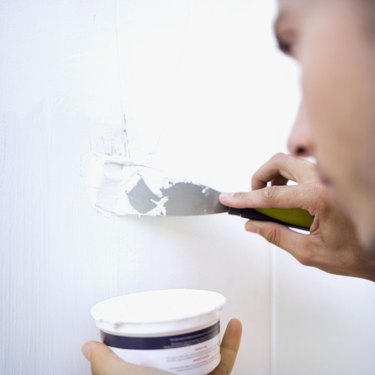
Drywall is the most common wall material used in new construction homes, and with good reason. Installation is quicker than plaster, and it gives an even canvas for paint or wallpaper. Unless your home was built before the mid-1950s, your walls are likely drywall. Joint compound and drywall are ideal partners, and you can repair most holes with a few tools and techniques. If your walls are plaster, joint compound may still help.
Large Holes
Video of the Day
Holes that are larger than a few inches require a drywall patch, joint compound and a brace; a 1-by-2 or 1-by-4 board is usually sufficient. Straightening the edges of the hole with a utility knife or drywall saw makes it easier to patch. Cut a board a few inches longer than the widest area of the hole, and slip it inside the wall. Pull back against the board, holding it against the back side of the wall, as you insert drywall screws through the wall and into the board. Gaps between the drywall patch and the perimeter of the hole are difficult to bridge, so cut the patch as close to the dimensions of the opening as possible. A rotary tool with an all-purpose cutting bit can shape drywall with precision, but a utility knife or drywall saw will also work. After fastening the patch to the brace with drywall screws, spread a thin layer of joint compound along the seams and cover the compound with drywall seam tape. The edge of a wide drywall taping knife will flatten the tape against the joint compound. If the patch is taped smoothly, you will only need a thin layer or two of joint compound over the patch to blend it with the rest of the wall. A light sanding afterward will remove imperfections.
Video of the Day
Small Holes
Small holes, such as those created by a door knob, require a small patch to cover the opening, but they don't need a brace. Filling a small hole with joint compound alone will cause cracks, and the repair will eventually crumble. Rigid metal mesh patches with a lightly adhesive backing are available. Press the mesh against the wall over the opening, and cover it with joint compound. Flexible fiberglass mesh seam tape will also work, but it may require a few extra coats of compound before it is even.
Nail Holes
Joint compound fills nail holes in one coat, and it dries quickly. A putty knife is the best choice, as it spreads less compound on the wall than a taping knife. Within minutes after filling hole, you can wipe the wall with a damp sponge and touch up the paint.
Plaster Techniques
Plaster is harder than drywall, and it has a slight sheen. Drywall is uniformly flat, and covered with matte paper. Although joint compound was developed for drywall, it will repair plaster in many cases. Crumbling, cracked plaster should be assessed by a professional. Dry joint compound that you mix at home will create a stronger bond than premixed compound. Unless the hole is very small, such as a nail hole, it will require a drywall patch. The patch should fasten to the wood lathe strips inside the hole with screws. Lathe is the plaster's foundation. Sanding the plaster around the perimeter of the opening helps the joint compound hold. Apply joint compound and tape around the patch seam as if it were a drywall repair, and spread one or two more layers of compound over the whole patch. When the final coat is almost dry, mist the wall lightly with water and drag a rubber grout float over the surface to add some sheen.